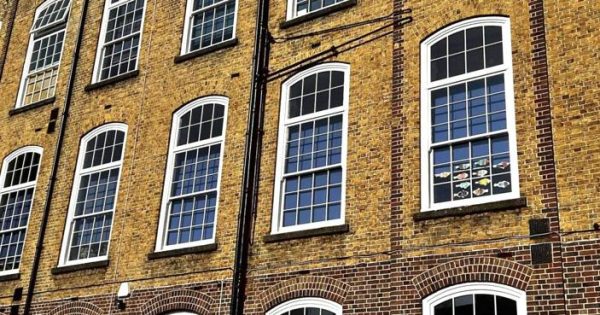Tue Sep 17
In the world of architecture and historic restoration, few elements capture the essence of period properties quite like the timeless elegance of timber sash windows. These classic fixtures have graced buildings for centuries, offering a perfect blend of functionality and aesthetic appeal.
At TRC Contracts, we’ve spent over 25 years perfecting the art of sash window construction, restoration, and replacement. In this comprehensive guide, we’ll explore the intricacies of sash window construction, highlighting how we balance traditional craftsmanship with modern demands to create superior products for architects and specifiers working on large-scale restoration projects.
What materials are traditionally used in sliding sash window construction?
Sash window construction traditionally uses wood, such as pine or oak, for the frame and sashes. The glass panes are typically held in place with glazing putty. These materials, combined with precise craftsmanship, ensure the durability and classic appeal of traditional sash windows.
The anatomy of a timber sash window
Before delving into the construction process, it’s essential to understand the various components that make up a timber sash window. Each element plays a crucial role in the window’s functionality, structural stability, and overall performance.
The window frame
The window frame forms the foundation of the sash window, providing structural support and housing the sliding sashes. At TRC Contracts, our standard frame dimensions are 100 x 140 mm (lining width x frame depth). We manufacture these frames using mortise and tenon joints, which are both glued and mechanically fixed for maximum durability.
The sashes
Sash windows typically consist of two sashes – an upper sash and a lower sash – that slide vertically within the frame. Our sashes are constructed with the following dimensions:
- 39 x 45 mm top rail and stiles
- 90 x 55 mm bottom rail
- 45 x 55 mm meeting rail
The sash box
The sash box is a crucial component of the window frame, housing the pulley system and sash weights that enable the smooth operation of the sashes.
Glazing bars and panes of glass
Glazing bars divide the window into smaller panes of glass. This not only adds to the aesthetic appeal but also allows for easier replacement of individual panes if needed. At TRC Contracts, we offer solid glazing bars as standard, measuring 24 x 45mm with an ovolo profile.
The counterbalance system
Traditional sash windows use a weight and pulley system for counterbalancing. This system consists of:
- Sash weights (typically made of cast iron)
- Sash cords
- Pulleys
Window sill
The window sill is the horizontal piece at the bottom of the frame. We offer various sill projection options ranging from 35mm to 110mm to suit different architectural requirements.
Hardware and ironmongery
Various hardware components complete the sash window, including catches, locks, and handles. We provide angel locks and sash stops as standard, with options for additional security features.
The construction process at TRC Contracts
At TRC Contracts, we’ve honed our sash window construction process to perfection, combining traditional joinery techniques with modern manufacturing methods. Here’s an overview of our approach:
- Material selection – We primarily use engineered redwood for the frame and sashes, with solid hardwood for the bottom sill. For projects requiring enhanced durability or specific aesthetic qualities, we also offer engineered hardwood, Accoya, and European oak options.
- Frame and sash construction – Our skilled joiners craft the frame and sashes using traditional mortise and tenon joints. This time-honoured technique ensures structural integrity and longevity.
- Glazing – We use traditional putty glazing methods to secure our high-performance Slimlite glass. This approach maintains an authentic appearance while providing modern acoustic and thermal benefits. We offer both single and double-glazing options to meet various performance requirements.
- Finishing – Each window receives a three-coat spray-applied microporous water-based paint finish. This not only enhances the window’s appearance but also ensures smooth operation and optimal performance. We offer white (RAL 9016) as standard, but can accommodate any RAL colour or stain from our range to match specific project requirements.
- Hardware installation – We fit all necessary hardware, including the pulley system, sash weights, and security features like angel locks and sash stops.
- Quality control – Every window undergoes rigorous quality checks to ensure it meets our exacting standards before leaving our factory.
Balancing tradition with modern demands
While we pride ourselves on our traditional craftsmanship, we recognise the need to meet modern performance standards. Here’s how we incorporate contemporary features without compromising on authentic aesthetics:
- Energy efficiency – Our double-glazed options feature 4/6/4 Low-E glass in the top sash and 4 toughened/6/4 toughened glass in the bottom sash. This configuration significantly improves thermal performance compared to single-glazed windows.
- Draught-proofing – We incorporate concealed draught-proofing measures to enhance comfort and energy efficiency without altering the window’s appearance.
- Ventilation – For projects requiring additional ventilation, we offer concealed through-frame head trickle ventilators with various airflow capacities.
- Safety and security – Child restrictors and enhanced locking mechanisms can be incorporated to meet modern safety standards and building regulations.
- Noise reduction – Our double-glazing options provide improved acoustic performance, making them suitable for properties in noisy urban environments.
Why choose TRC Contracts for your timber sash window construction needs?
- Unparalleled expertise – With over 25 years of experience in timber sash window restoration and replacement, we bring unmatched expertise to every project.
- Bespoke solutions – While we offer a comprehensive standard range, we specialise in creating bespoke windows to meet unique architectural requirements.
- Quality assurance – Our standard range holds testing certification from independent UKAS accredited testing houses, ensuring performance you can trust.
- Sustainable practices – We use sustainably sourced timber and environmentally friendly finishes, aligning with modern sustainability goals.
- Comprehensive service – From initial design consultation to manufacturing and installation, we offer end-to-end solutions for large-scale restoration projects.
- Heritage specialisation – Our windows are ideal for listed buildings and conservation areas, where maintaining authentic aesthetics is paramount.
Transform your project with TRC Contracts’ expertly crafted timber sash windows
Sash window construction is an art that requires a delicate balance between preserving traditional craftsmanship and meeting modern performance demands. At TRC Contracts, we’ve mastered this balance, offering timber sash windows that combine classic design with contemporary benefits.
Whether you’re working on a historic restoration project in London or a new development inspired by period architecture, our expertise in sash window construction ensures you’ll receive products that exceed expectations in both form and function.
Ready to transform your next project with premium timber sash windows? Contact TRC Contracts today to discuss your requirements and discover how our bespoke solutions can bring your architectural vision to life.
Visit our profile on NBS Source
As a trusted and reputable supplier, TRC Contracts is proud to be a member of NBS Source. Our profile on NBS Source provides architects with easy access to detailed information about our products and services, making it even more convenient for you to explore the range of sash windows we offer.
Visit our profile on NBS Source today to learn more about how TRC Contracts can meet your project requirements and deliver exceptional results.
Discover more with TRC Contracts
Choosing the right window style for your architectural design
Advancements in window restoration techniques
The benefits of triple glazed sash windows in historic buildings





